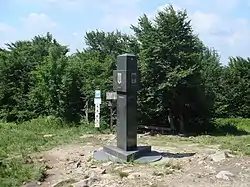| Poland–Slovakia border | |
|---|---|
 Map of the Beskid Mountains straddling the Poland–Slovakia border | |
| Characteristics | |
| Entities | |
| Length | 541 kilometres (336 mi) |
| History | |
| Established | 1 January 1993 |
| Current shape | 23 July 2005 |
The Poland–Slovakia border is the international border between Poland and Slovakia and has formally existed since 1 January 1993, following the dissolution of Czechoslovakia into two independent states. Before the dissolution of Czechoslovakia, its eastern border with Poland was practically identical to the present day border between Poland and Slovakia, with minor corrections made in later years. The length of the Poland–Slovakia border is 541 kilometres (336 mi)[1]
Course of the border

The border with Slovakia runs from Jaworzynka Trzycatek through the Zwardońska Pass, Wielka Racza, Wielki Rycea, the Glinka Pass, Pilsko, Babia Góra, Chyżne, crosses the Orava valley, the main ridge of the Tatra Mountains, runs along the Białka valley, along the Dunajec valley, through the Pieniny, the Poprad valley, through Muszyna, the Tylicka Pass, the Dukla Pass and the Łupków Pass, to the Uzhok pass.
History

When the Slovak Republic was established on March 14, 1939, under the auspices of Nazi Germany, the Czechoslovakia–Poland border ceased to exist. In its place appeared the first Czechia-Poland border for the Protectorate of Bohemia and Moravia, the Poland–Slovakia border, and a new Hungary–Poland border.
The first Poland–Slovakia border began 550 metres (1,800 ft) west of the Mały Połom mountain (Trojačka) at 1,058 metres (3,471 ft) above sea level, then ran east through the Vel mountain. Polom (1,067 metres (3,501 ft) m above sea level), south of the Jablunkov Pass, north of Czacy and Czarna, then through Wielka Racza, Pilsko, Babia Góra, Chyżne, crossed the Orava valley and the main ridge of the Tatras. Then it ran through the Białka valley along the Dunajec Valley, through the Pieniny Mountains, through the Poprad valley, through Muszynę and ended its course at the top of Czernin (Černina) (929 metres (3,048 ft) m above sea level) in the vicinity of Łupków, where the tripartite borders of the Second Polish Republic, the Slovak Republic and the Kingdom of Hungary were located. The Poland–Slovakia border survived in fact until 28 September 1939, when it became the Nazi Germany–Soviet Union border, and formally until 1958, because only on June 13, 1958, the governments of the Polish People's Republic and the Czechoslovak Socialist Republic signed an agreement solving border disputes.
2005 adjustment
Pursuant to an agreement between the Republic of Poland and the Slovak Republic drawn up in Lubovla on 29 July 2002 and ratified on 17 October 2005,[2] Near the observation tower on the Dukla Pass in the area of the Polish town of Barwinek and the Slovakian town of Vyšný Komárnik, Slovakia gave up 376 square metres (4,050 sq ft) of territory, and Poland handed over territory of the same area (the change was dictated by the inability to restore the common border road to its previous state; built in 1958 to allow Slovak tourists to see the places of fighting. After correction, the border runs the middle of the road) on the Dunajec river in the vicinity of the Polish towns Sromowce Niżne and Sromowce Wyżne and the Slovak towns of Červený Kláštor and Spišská Stará Ves, part of the unnamed island with an area of 2,289 square metres (24,640 sq ft) surrendered to Slovakia, and Slovakia gave way to part of the island of Nokiel with the same area (the change was dictated by the lack of possibility to settle border marks in the right places, due to the shape change of the island).
In the area of the Polish town of Jaworzynka and the Slovakian town of Skalité, Poland withdrew from 304 square metres (3,270 sq ft) of territory, and Slovakia withdrew territory of the same area (the change was dictated by the residents' requests - after 1953 a road was crossed there several times across the border, causing many difficulties in access to plots on both sides, now the border runs the middle of the road). In total, Poland has transferred to Slovakia, and vice versa territories with an area of 2,969 square metres (31,960 sq ft) (nearly 0.30 hectares (0.74 acres)).
See also
- Territorial changes of Poland
- Border Guard (Poland)
- Extreme points of Poland
- Geography of Poland
- Poland-Slovakia relations
- Polish border crossings